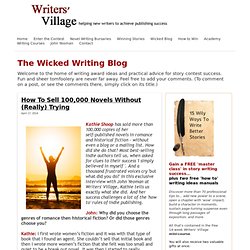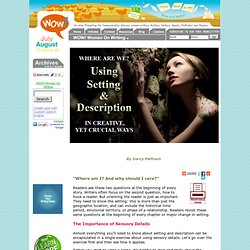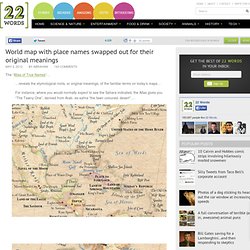

Wicked Blog. Kathie Shoop has sold more than 100,000 copies of her self-published novels in romance and historical fiction – without even a blog or a mailing list.

How did she do that? Most best-selling indie authors tell us, when asked for clues to their success 'I simply believed in myself '. And a thousand frustrated voices cry 'but what did you do? ' In this exclusive interview with John Yeoman at Writers' Village, Kathie tells us exactly what she did. And her success challenges a lot of the 'how to' rules of indie publishing. John: Why did you choose the genres of romance then historical fiction? Kathie: I first wrote women’s fiction and it was with that type of book that I found an agent. Kathie: My agent was not successful in selling my work and felt that she didn’t see a market for my historical fiction. My novels were piling up and remaining unsold and I knew there was a market and that I could find the readers who wanted to immerse themselves in a world set in the Dakota Territory, 1887. Show, Don’t Tell—Using Setting to Deepen Your Characters. Image courtesy of Melinda VanLone WANA Commons Social media is an amazing tool, and it is a wonderful time to be a writer, but, I am going to point out the pink elephant in the room.

We still have to write a darn good book. If we don’t write a darn good book, then no amount of promotion can help us. Sorry. That’s like putting lipstick on a wildebeest. Not only am I here to help you guys ROCK building an author platform, but I’m also here to train you to be stronger writers…and make you eat your veggies and sit up straight. Many times I am asked to expound on the difference between showing and telling. Debbie Johansson WANA Commons Today we are going to talk about setting and ways to use it to strengthen your writing and maybe even add in some dimension. Setting can help your characterization. Setting can actually serve a dual role in that it can be not only the backdrop for your story, but it can also serve characterization through symbol. Now you have shown me that Buffy is not herself.
Fiction Writing: Using Setting and Description in Creative, Yet Crucial Ways. “Where am I?

And why should I care?” Readers ask these two questions at the beginning of every story. Writers often focus on the second question, how to hook a reader. But orienting the reader is just as important. They need to know the setting: this is more than just the geographic location, and can include the historical time period, emotional territory, or phase of a relationship. The Importance of Sensory Details Almost everything you’ll need to know about setting and description can be encapsulated in a single exercise about using sensory details. Before you start to write a scene, it’s helpful to stop and think about the sensory details of the situation. I like to stop, close my eyes, and imagine that I’m the character—a young girl, at the opening of a cave about to go in. Once I have the details firmly in mind, I start to write: I hesitated, my heart thumping, at the boundary between light and dark.
You can easily evaluate how well you’re doing on using a variety of senses. 1. World map with place names swapped out for their original meanings. The “Atlas of True Names“… …reveals the etymological roots, or original meanings, of the familiar terms on today’s maps…For instance, where you would normally expect to see the Sahara indicated, the Atlas gives you “The Tawny One”, derived from Arab. es-sahra “the fawn coloured, desert”….

(via Weasel King) Update: There is now a more in-depth version specifically for the United States.